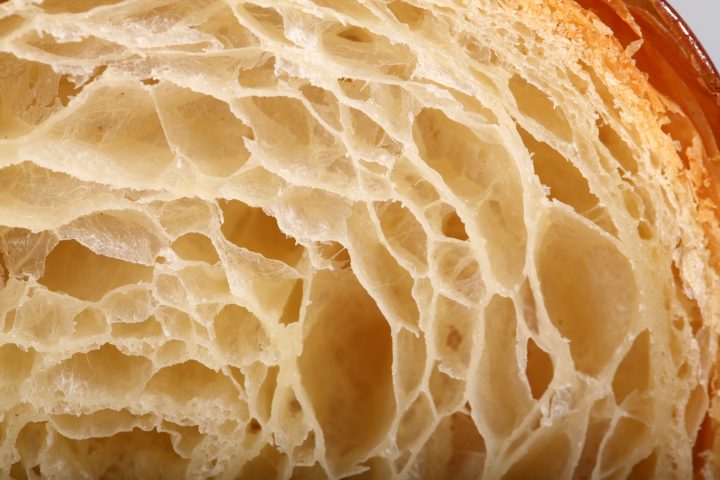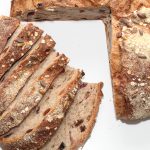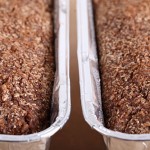
FACQ is still a work in progress, but we published it because it could hopefully already be useful…
A lot of (first time) croissant bakers ask pretty much the same questions when tackling this challenging pastry. We composed a list of the top questions with our answers. Pretty sure your question will be answered here. If not, just put your question in a comment below. Now lets get to the point of your very valid questions!
GENERAL RECIPE QUESTIONS
Why is your version a three day recipe?
The three day croissant recipe schedule is done for the right planning of the whole process so you can make your croissants on the third day in the morning, but of course you can take less time if this fits your timing better. Take a look at our one day version of this recipe too.
I am a first time croissant baker. What is your best advice?
Choose a cold day with a room temperature below 20 ºC / 68 ºF for your first attempt. This way you will have more time for the whole process and less chance of butter being absorbed by the dough. The key is to keep the butter solid between the layers of dough, this is what gives the croissant its flakiness.
My first attempt croissants look nothing like the ones in your pictures! What did I do wrong?
Do not expect to get perfect croissants the very first time you try to make croissants, most people need to make them 3 to 4 times to get the general feeling for the process. There is no substitute for practice and experience. There is no way to hide little mistakes in your technique when making croissants, so work very precise and follow the instructions to the letter. One small mistake is no problem but several small mistakes add up!
My croissants have a bread-like crumb and no layers. What did I do wrong?
Several factors can be the cause of this. Most likely it is an accumulation of things going sideways. It starts with pressing too hard on the dough to try and lengthen it while it is already fighting back. Keeping at this for a while means, next to the pressing on the dough, you are taking too long and the butter starts to get warm and is absorbed by the dough. So in this case, while still learning and getting better and faster, until you do make sure you build in extra fridge time to cool the dough and then continue. Handle the dough with care, gently elongate without pressing too much or putting your weight into it.
Can I turn your croissant recipe into a sourdough version?
We would recommend finding a recipe that is already a worked out version for sourdough croissants. We are not really a fan of the sour taste in pastry and for that reason we do not have enough experience to guide you to a good enough result.
Can you provide the measurements as ml, tsp, cups, instead of grams for all the ingredients?
We very much recommend weighing your ingredients. Professional bakers use scales (also in the US) and in Europe home bakers do too. A scale will give you the exact same weight every time. Which is absolutely needed if you consistently want to make good bread and especially good pastry. You can get a scale for the same price as a few sacks of good flour and less than a lot of baking tools you already own, so if possible, go and get one!
What are the measurements if I only want to make half of your recipe?
If you halve the recipe, the dough square should be 18.4 x 18.4 cm and the butter slab 12 x 12 cm.
Put the butter slab on top of the dough square and wrap the butter.
Roll the dough into a 20 cm x 30 cm rectangle.
Fold letter style to a 20 cm x 10 cm rectangle.
Turn dough 90 degrees.
Roll from the short 10cm side to a 20cm x 30cm rectangle (the short 10cm side will get 30cm).
Turn dough 90 degrees.
Roll from the short 10cm side to a 20cm x 30cm rectangle (the short 10cm side will get 30cm).
Turn dough 90 degrees.
Roll from the short 10cm side to a 20cm a 55cm rectangle (the short 10cm side will get 55cm).
The size of the final dough, right before cutting, should be 20 x 55 cm.
Although it is possible to use halve the dough we advise to make the full recipe as described in the recipe as the geometry of the shapes are much easier to work with.
You can always use halve and freeze the other halve.
I want to bake croissants, but live in a tropical location. Can I still make them?
We have gotten tips from people who have successfully baked croissants in the tropics. The top tips:
Cool ingredients and even utensils in the fridge before use, and use the fridge a lot to cool your dough and cool for longer if needed.
Roll the dough at night, when it is cooler. Check the weather reports and choose the coolest period possible.
BUTTER
My butter breaks into pieces. What should I do?
We use organic butter with a high fat content and low water content (about 82% fat). A higher water content tends to make butter hard, which promotes tearing and breaking and ruins the layers. Your butter needs to be pliable and at the same time not too soft at the moment of usage.
Help, butter leaks out when baking!
Your croissants were probably under-proofed. Just let them proof a bit longer so they get wobbly and increase visually in size. When under-proofed the butter tends to leak out from in between the layers and you end up with a butter puddle.
There’s so much butter in these croissants! Can I use less?
We would suggest making the recipe with the amount of butter indicated, enjoy the croissants and just try to eat less instead of a less than buttery croissant.
Next day eat soup and a salad.
FLOUR
Can I use another type of flour than the French type 55 you use?
For a good croissant you need the right type of flour. We have tried at least 5 different types and brands before we found a winner. If you cannot get the type 55 French flour try to find a flour with around 11% protein (this can be an all purpose / plain flour) and make sure it is a good quality flour. Try different brands if needed or use a combination of flours. Using 100% bread flour can make your result ‘heavy’ so try a combination with all purpose for instance.
DOUGH
My dough was too moist and sticky to handle. What should I change?
First of all it seems your flour absorbs less moisture than the type 55 flour we are using and you need to make adjustments by using a little less moisture next time.
My dough resists and shrinks back when I try to roll it out. What can I do?
At any stage when the rolling of the dough gets harder you can cover the dough and let the gluten relax for 10 to 20 minutes in the fridge before continuing.
If you keep on pressing the dough, trying to roll it while it resists, you will damage the layers!
SHAPING, PROOFING & YEAST
Can I use fresh yeast instead of instant yeast?
Yes you can. Use three times the amount given (so for our recipe 33 grams of fresh yeast).
Can I use active dry yeast instead of instant yeast?
Yes you can. Use 1.2 times the amount given (so for our recipe 13.2 grams active dry yeast).
At what stage should I add filling to my croissants?
You add filling just before the shaping / rolling up stage. Be aware that any filling will affect the layers and you will need less filling than you probably think. With chocolate for instance you will need no more than 5 to 7 grams per croissant. Professional bakers use stick chocolate for this, but you can use your own good quality (dark) chocolate. Fillings like jams are often added (injected) after baking.
I want to shape my croissants like a crescent. Why are your croissant not crescent shaped?
According to Raymond Calvel croissants laminated with margarine are formed into the crescent shape, while croissants laminated with butter are left in the straight form. We say, use whichever shape you like best, but do use real (organic) butter!
My croissants do not puff up like yours. What should I do?
First check the ‘sell by’ date on your packet of yeast and see if it is still OK to use it. Also make sure the temperature of your dough and proofing environment are correct.
Ideally you should proof the croissants draft-free at a temperature of 24ºC to 26.5ºC / 76ºF to 79ºF
BAKING
Why are my croissants under/over cooked?
Check the true temperature of your oven and see if any adjustments need to be made there. See our tips on the subject: Bread baking tips: Making the most of your oven.
Why are there pools of butter at the bottom of my baking pan when baking the croissants?
This could be a result of under-proofing, so make sure you proof at the right temperature and take the time to proof to perfection and get that nice wobble in your dough. It could also be you were not as meticulous as needed during the lamination process, so stick to the measurements, make sure they are as exact as possible, the edges are straight and follow our laminating instructions carefully.
Help my croissants split open during baking! What did you do wrong?
We suspect your croissants lack real layering and therefor are more bread-like with a lot of butter incorporated. Because they have this substance and are under-proofed and lack layering, you get an oven-spring during baking and the bread splits at its weakest points. With correct layering you get air pockets which will be able to expand and not rupture.
So try to work on your layering by keeping the laminated dough cool, work fast and do not press on the dough when rolling it but gently elongate it.
I want to freeze my croissants and bake at a later stage. What is the best way to do this?
Check out our tips for retarding and freezing with the one day version of our croissant recipe.
You can always find a way to adjust the recipe to fit your schedule.
What do I do to keep baked croissants fresh?
We would advice to put the croissants you do not eat on baking day in the freezer, after they have cooled. For extra flakiness and ‘almost as good as freshly baked’ you can put them into an oven for about 8 minutes at 175°C / 345°F, straight from the freezer.










ahmed Ali helal says
why after baking the croissant its looks like dough inside no layers
Weekend Bakers says
If your croissants are doughy inside and not properly cooked, we would suggest there may be something not right with your oven. Check the true temperature of your oven and see if any adjustments need to be made there. See our tips on the subject: Bread baking tips: Making the most of your oven.
Also check the information under General and baking questions for more helpful tips.
Ritu says
The Center of the croissant is doughy and seems uncooked. Any suggestion is most welcome
TIA
Weekend Bakers says
Make sure when proofing you do so at the right temperature and take the time needed to get to the right proofing stage. Being able to measure your dough temperature can be key to a better result, so if possible invest in a digital (probe) thermometer.
Also important: Make sure your oven is indicating the right temperature (see our tips: www.weekendbakery.com/posts…your-oven/).
Maybe superfluously, but always resist the temptation to open the oven door, especially in the earlier stages of baking. You will not believe how much heat is lost with most ovens by opening the door for just a short while…
Good luck with your next bake!
Betsy Hudson says
Thank you for all the great tips. I didn’t see my issue, though. If you have any thoughts I’d be VERY happy to hear from you.
My croissants looked fine but inside was dense; they did not have the honeycomb flakiness as in your photo.
I had very well-defined pastry layers*, but they were greasy layers.
Here were my 2 thoughts:
1… I didn’t roll out thin enough? Final thickness when cutting the triangles was close to 3/16″ (5mm) while my instructions said 1/8″ (3mm)
2… I should have proofed in a cooler environment? I proofed at around 73 degrees F, for 2 hours.
Baked at 400 for 10minutes then reduced to 375 for 15 min.
I used Kerrygold butter and all-purpose flour.
Note: Trying for “pretzel” croissants so I used baking soda wash instead of egg wash.
*I’d love to attach a photo but don’t see how to do so.
Your thoughts would be so appreciated.
betsy
Weekend Bakers says
Hello Betsy,
The first thing we notice by reading your comment is that you did a lot of things different from the original recipe. We always recommend strongly to make the recipe exactly like we wrote it down and only change things after a few successful bakes.
The proofing should be at a higher temperature preferably around 78 (but not higher) or, if lower, it should be longer. So we think your dough was underproofed and that is why butter leaked out and the layers where greasy.
To get good layers, you should also keep as close as possible to the measurements and work precise.
Hope you will give it another try!
Colleen says
Ok. I have tried making tge butter croissants out of the Tartine book several times. The first time I made them I had great success. Since then, it’s been a no go. They won’t proof. Tonight they sat in a large plastic bag for 3 1/2 hours. Proofed a little, but not enough. They bled butter and were dense. I’m wondering if I shouldn’t change up the yeast to instant. It’s maddening.
Weekend Bakers says
Sorry , we are not familiar with this recipe, but trace your steps and see what you did different from the first try. Did you change ingredients or is your yeast past the sell by date…
Rajkamal says
Hi, good evening sir/madam;
My croissant shape everything comes good, colour also good but why inside comes hole in that. I am trying more time but still I didn’t get proper solution for that. Please help me for this problem . Thank you
Weekend Bakers says
Hello Rajkamal,
Try and roll up the very well and carefully when shaping, so give this extra attention. Just keep practicing and with every turn you will get better and quicker. Above all be very precise when you laminate so you get nice even built up layers that will help also with a good structure inside.
Christy says
How to make croissants that are still flaky even after a day of storing in room temperature? Without having to rebake them again.
Weekend Bakers says
Hello Christy,
It is very hard to keep bread and pastry fresh without adding all kinds of ‘additives’ that we at least rather not use in our baking. So after a day at room temperature your pastry will have lost some of its original freshness. We always advice to store croissants you do not eat in the freezer for best kept freshness and use the method of a quick turn in the oven like described above.
If you want to know more about planning your bakes and freezing and retarding unbaked croissants see the description of our method at the bottom of this recipe: www.weekendbakery.com/posts…nt-recipe/
Happy pastry baking!
James says
Regarding proofing: Should it be a dry proof or a moist proof. I understand the temperature should not get above 80F or the butter could leach. I am building my own proofing box and want to know if I should account for a water pan with a small computer fan to circulate the moist air or not.
Cheers,
james
Weekend Bakers says
Hello James,
We would recommend a moist proof if possible!
Hope your proofing box will be a success.
Peggy says
Hi,
I have another question. When I rolled the dough the first time (right after enveloping the butter slab), it rolled out beautifully with butter extending all the way to either end of the dough.
After chilling for 30 mins, on the second roll, the butter starts breaking up, with some parts having thicker butter and some parts having none or very little. Is this because the butter was too cold? Or what could be the reason?
Thanks,
Peggy
Weekend Bakers says
Hello Peggy,
We use organic butter with a high fat content and low water content (about 82% fat). A higher water content tends to make butter hard, which promotes tearing and breaking and ruins the layers. Your butter needs to be pliable and at the same time not too soft at the moment of usage. So make sure you use the right kind of butter and make sure your butter slab is nice and even like you see in our pictures and video: www.weekendbakery.com/posts…roissants/
Enjoy the process!
Peggy says
Yes, I use high fat content butter too. The first roll out is nice and even, but after chilling for 35 mins do you think the butter becomes too cold?
Weekend Bakers says
Yes that could be the case. Just wait 5 minutes, maybe 10 and try again. Do not use force, be gentle and do not press on the dough by hanging on it with your weight.
Peggy says
Thank you for these tips!
I have two questions:
1) After baking, and cooling, the top most layer isn’t “crunchy” when I bite into it, instead it’s a little “chewy” yet still on the crispy side, so unlike bread. How can I make it a little more crispy?
2) In the oven, the croissant puffed up even more, and the extra puffed up / exposed layers don’t brown and remain very pale. How can I rectify this?
Weekend Bakers says
Hi Peggy,
What oven settings did you use and how close where the croissants to the heat?
Peggy says
Hi, I have a conventional oven, set to 375F, and croissants are in the middle rack, baked for 16-17 mins.
Thanks,
Peggy
Weekend Bakers says
Hi again Peggy,
We advice you to preheat the oven at 200ºC / 390ºF convection or 220ºC / 430ºF conventional oven. Then turn it down to 390 when you put in the croissants and if the browning goes too quickly turn it down a notch to around 340. You can also try and use the upper tier of your oven if the croissants are not too close to the heating elements this way of course.
You really have to learn from experience and by baking several batches what the ideal time and temperature is for your own oven. Above all do not open the oven door when baking. Most ovens loose so much heat this way.
Hope it will be great!
Peggy says
Awesome, thank you!
seema latif says
hi, thanks so much for all the helpful hints. i am a beginner with croissants. i hav ebeen following your recipe but although my croissants do have many layaers, they dont have a honeycomb effect your do. also i have tried proofing them for over 2 hours but they still ooze butter while baking. what am i doing wrong. any jelp from you will be appreciated.
Weekend Bakers says
Hello Seema,
Next to the time you take for proofing, the temperature you do it at is also key. So you need to be able to proof at the right temperature. If your dough is a few degrees colder, it can take much longer to get to the perfect proofing stage. Also the laminating needs to be precise and this could take practice. So if butter still leeks out too much (a little bit is no big deal) this will also have effect on the inside structure of the croissant. So if you have these elements under control, you can also vary with different brands of flour and your oven temperature and time. So lots of factors and many bakes, but hopefully in the meantime you will still be eating lovely fresh croissants, better than most you can buy 🙂
Good luck with it!
Trish says
Hi. I am a first time at this but had a lesson a month ago and can’t remember seeing any butter but today my dough has butter laminations. Is this normal please?
Weekend Bakers says
Sorry Trish, we do not understand what you mean by butter laminations exactly. Do you mean butter is leaking out?
Chad says
Croissants are gummy and no crumb.is it baking proofing or shaping or mixiing?lamination is spot on.
Weekend Bakers says
Hello Chad,
We are not sure what you mean by gummy and no crumb, do you mean no layers? We would guess that proofing is often a key part that is cut too short. What flour did you use with what protein content?
Ahyan Abassi says
Are my croissants messed up if a little butter is peeking out through the dough :(?
Weekend Bakers says
Hello Ahyan,
It depends on what your dough looks like, of course it is best if no butter is visible and it is all sealed in, you will only know after baking how well the layers where formed.
Hayley says
Like one of the comments above, my dough resists and shrinks back when I try to roll it out—but even immediately after it was rested. By the third turn it takes a near Herculean effort to roll it out at all. I’ve tried two different recipes so far with the same problem. Could it be too much mixing over developed the gluten? Too much hydration? Thanks!
Weekend Bakers says
Hello Hayley,
Have you looked at your flour and the protein content? What type of mixer are you using and at what setting?
Hayley says
Thanks for your response! I’m using Gold Medal AP, which has a 10.5% protein content. I live in a rural area and can’t get the French 55 without special ordering. I originally tried with Bouchon Bakery’s recipe which said to mix at low speed for 20 min, which maybe was the problem. I’m trying again today following your method and mixed for about 3 min with slightly less water. I have a 3.5 quart kitchen aid for a mixer. (I also watched your videos, which were helpful! I think I’ve been having to press much too hard on the dough.)
Weekend Bakers says
Hi again Hayley,
We do not have experience with this flour but if the hard work persists we would encourage you to also try a different flour. Next to gluten percentage there’s also difference in gluten types which accounts for the amount of extensibility and elasticity, so there can be a difference from one flour to the next and it could still be this flour gives more elasticity than desired for this recipe.
See: www.weekendbakery.com/posts…ut-gluten/
We think the right setting for the KA would be 3 or 4.
It may take some more practice and trial and error but we hope you will find the right successful formula for you!
Ahyan Abassi says
No problem! Just put it in the fridge for 20-25 minutes and once you take it out it will make a huge difference. This is a very common case among croissants.
amin says
کروسانهای من موقع پخت در فر از وسط پاره میشوند
amin says
Why does croissant dough break when baking
Weekend Bakers says
Hello Amin,
This can first of all be a sign of under-proofing so try to proof the dough for as long as possible. If your laminating also is not ‘good enough’ this will also make it worse, so try and work as precise as you can when building the layers. If the layers are good, the air between the layers can expand without the whole croissant breaking at the weakest point.
Good luck with it!
Yogendra says
I am using all purpose flour but couldn’t make same puff in side.
I really loved it and looks good but i couldn’t make well. Can you send me your video?thanks.
Weekend Bakers says
Yes, you can find the croissant video here:
www.weekendbakery.com/posts…roissants/
Try and use if possible flour with 11% protein or a bit more. Maybe try a combination of all purpose with 25% or so stronger bread flour.
Good luck with it!
Ksam says
Please ilooking to make lik this proudct can you gide me
Karuzo pie cream puff
Weekend Bakers says
Sorry, we do not understand what you are asking for…
Maxim says
Thanks for the recipe! My croissants are almost perfect except for two things: they are not enough crispy and puffy for my taste. So will proofing them for more then 2-3 hrs help make them more puffy (with bigger “honeycombs”)? And what can I do to make the outer layer more crispy? Also it’s pretty hard to roll out the dough to 110 cm sheet with the same thikness along the entire length, is there any methods to roll out it more… even?
Weekend Bakers says
Hello Maxim,
We would say yes, if we could estimate how far or perfect your croissants where proofed already. You need to judge this by yourself by measuring the temperature of the dough and looking at the wobble et cetera, like we say in the recipe. When in doubt, give it 15 minutes more then check again. Maybe there’s some room for further proofing and this will improve the structure too.
About the crispy outer layer: Make sure you apply the two coatings of egg wash, make sure your croissants all have enough room in the oven so heat can get everywhere and make sure your oven temp is correct.
There are tools for controlling the thickness of dough, they are called something like pastry rulers (you can also make something yourself if you are a bit DIY minded). But with practice and careful and gentle rolling out you should get better at it too. If needed and more practical and easier to handle , you can roll out the dough to say 80 cm, then divide this piece into two equal parts and roll each part to 55 cm.
Hope it will be even more perfect on your next bake!
Rashmi Keshav says
My croissants have become really hard. What could be the reason?
Weekend Bakers says
Hello Rashmi,
Do you mean after baking or when have they become hard?
Alice Wrigley says
Hi, I was so excited to find your recipe when googling went all my butter was leaking!
All went swimmingly with the recipe until it came to baking… It seems like they grew too much then collapsed. Great taare and texture and no leakage, just huge and flat!
Did they proove too long? Oven needs to be hotter? Did I make them too big? Too much yeast?
Help gratefully received! Can’t wait to try your other recipes.
Thank you
Alice
Weekend Bakers says
Hello Alice,
Our answer to your question is that your croissants were very probably under-proofed and maybe the dough was also under-developed. If you can tell us how long you proofed them and especially at what temperature we can say it with more certainty. When you underproof and the dough is not ready for the oven, the croissants expand but they do not have enough strength /structure and they collapse. Make sure when proofing you do so at the right temperature and take the time needed to get to the right proofing stage.
Also important: Make sure your oven is indicating the right temperature (see our tips: www.weekendbakery.com/posts…your-oven/).
Maybe superfluously, but always resist the temptation to open the oven door, especially in the earlier stages of baking. You will not believe how much heat is lost with most ovens by opening the door for just a short while…
Enza says
My first time making croissants. My dough is not as soft and playable as I see in the video. I added some more milk but it’s still firm. I followed the recipe and instructions on how to knead the dough and is still tough. Tomorrow I will be doing the second turn. I’m hoping the dough softens by then. Can you tell me what I’m doing wrong.
Weekend Bakers says
Hello Enza,
Can you tell us what flour you are using and what the protein content is? It could be you would need even a bit more liquid until you have the right consistency like you see in the video.
Laura says
I’ve made croissants but my chocolate ones did not have a honeycomb texture while my plain ones did. It was the same batch so what caused this? Undercooking?
Weekend Bakers says
Hello Laura,
Filling, added before the baking process will always interfere somewhat with the forming of the layers, especially from the bottom up. We do not know how much filling you added, but you only need a small amount like we say above. If you think more filling is better, then you will see the layering will be less and less developed.
Also pay extra attention to the tight shaping of the croissant.
Dasaradh says
what can happen if croissant dough is proofed at high temperature for a long time
Weekend Bakers says
Hello Dasaradh,
As we say above: Ideally you should proof the croissants draft-free at a temperature of 24ºC to 26.5ºC / 76ºF to 79ºF
If the temperature is higher butter will leak out of the dough and you will not get any layers or good honeycomb structure. The combination of high temperature and longer time will also increase the chance of over-proofing of the dough, the gluten structure will be damaged and the dough will eventually collapse.
Sunita says
And doesn’t have that nice looking honeycomb inside. What must have gone wrong?
Weekend Bakers says
Hello Sunita,
It is very probably a combination of factors (see above) because you have yet to gain some experience and speed with the process. Because the layers maybe are not well formed and possibly your oven and / or the cooking time needs a bit of adjustment (see our tips: www.weekendbakery.com/posts…your-oven/).
Hope you will try again and see the progress!
Claudine Tocci says
What makes a croissant bland and kinda dry? If butter comes out of the layers while Rolling is the dough ruined?
Weekend Bakers says
Hello Claudine,
It is definitely not a good sign and the quality will be compromised. Butter gives flavour, texture and taste. If you notice butter coming / running out, take the dough to the fridge right away and let it rest in the fridge till the butter is more solid again. Never press too hard and make sure your butter is solid but pliable. With more experience you will also be able to work faster with less chance of butter getting too warm in the process.
Ekant Jain says
Hi. Great insight. I have been making croissants since years and I will proudly say that it comes out just right. I am actually looking for the coloured dough sheet recipe that everybody is applying on the rolled croissants dough, I love the texture that finally comes out. Any help will be highly appreciated. Thank you.
Weekend Bakers says
Hello Ekant,
We must confess we have never tried that but it is beautiful and intriguing but the end result of the actual croissant (inside) usually is a bit less impressive.
Hope you find what you are looking for and it will be great!
Charles P. says
Hi-
Thanks very much for responding with the suggestion that my oven temperature may not be well controlled. I have in the past made an effort to measure it and calibrate it , but I will do it again. But one of the problems, as I’m sure you know, is that oven temperatures are not stable and can fluctuate by as much as 50 to 100 degrees Farenheit, depending on the oven. In fact, if I open the oven door briefly and close it and the temperature drops by a substantial amount the oven makes no effort to correct for it. I have to turn it off and restart it.
But if you don’t mind, I would like to ask you about something else. As you know, one of the major challenges of making puff pastry or croissants is that the gluten has to be relaxed by refrigerating the dough an interminable number of times. So, the obvious question is why not use gluten-free flour. Have you had any experience along those lines, and with what results?
Thanks very much.
Weekend Bakers says
Hi Charles,
Although the gluten need to relax, you still need them to get the right dough structure. Lack of gluten you will not make for a good croissant, you will end up with more of a cake structure. Of course you can find recipes for gluten free croissants, but usually this means using a very special (combination of) flour and other ingredients. But we have to say we do not have any experience with baking gluten free pastry.
And good luck with your oven, it can be a challenge when so much heat is lost when opening the door, but needless to say, if possible, never open the door during the baking process if not absolutely necessary.
Good luck with it!
E says
hello! am at the end of day 2 and i have several burning questions.
1- is my dough supposed to rise while sitting in the fridge the night of day 1?
2- does the butter have to be rock hard (right out of the fridge) when i laminate?
i also noticed that my dough started tearing and the butter started to ooze out while laminating. are there anyways to salvage this or will this affect the baking process and the flakiness?
Weekend Bakers says
Hello E,
Yes your dough may rise in the fridge, just gently roll out the air.
The butter will soften very quickly usually out of the fridge, otherwise wait just a few minutes, it should be pliable but not soft.
Oozing of butter means it is too warm. Before that happens take it back to the fridge.
If you check the comments with the croissant recipe you will find many more helpful tips and experiences of other bakers and see that you are not alone with these issues and still need to practice to get some speed in the process. Above all: use the right butter like we say in the recipe.
Good luck!
Charles P. says
Hi- My croissants are perfect in all ways until baking time. Then no matter how I bake them I cannot get the inside to cook sufficiently. They look good and taste great and the honeycomb is there and the outside looks properly cooked, but the interior is a bit damp and undercooked, no matter what I do.
Thanks.
Weekend Bakers says
Hello Charles,
We think, reading your comment, that your croissants could very well be perfect and may not be undercooked. The inner folds of a croissant are softer / tender and certainly different from the outside which is very crispy.
But if you are sure they are, you could try and alter the baking process and first of all check if your oven indicates the right temperature and then have a few runs to get it right, because our guidelines are just that and it could be that your perfect times and temperatures with your oven need some adjustment.
J says
I’m getting great rise, nice shape, and good flavor, but my croissants are showing a spiral shape in the dough along with some gaping. I’ve made the batch several times and some batches are better while there show a more pronounced spiral. Any tips?
Weekend Bakers says
Hello J,
Our first suggestion would be to look at the shaping stage: try and roll the dough very tightly at the beginning and put enough pressure on the dough to make the layers stick together (but not so much as to damage the layers of course)
ashley weber says
Hi,
I don’t think my dough looks right. I have made this recipe in the past and usually it looks soft and light. It seems dense looking-is there something i can do to save it or start over?
I make this recipe every year for my anniversary since we eloped in Paris! <3
Thanks for the help 🙂
ashley weber says
Also, can the dough be frozen?
Weekend Bakers says
Hello Ashley,
Did you maybe do something different or use a different flour than last time. Was the yeast over its sell by date or were the conditions different?
You must judge if you want to continue if the answer to one or more questions is yes and before you are going to use the usually expensive butter.
And yes, dough can be frozen. For more tips on freezing and retarding the way we do it see the bottom halve of this recipe: www.weekendbakery.com/posts…nt-recipe/
ashley weber says
thank you!
Sommalada says
could you please guide why my croissants are flat even in the oven (I mean not puff up as it should to build a honeycomb crumbs? My last proof takes around 2.5 hours in the closed oven and they did wobble and jiggle when I moved the plate. The baking temperature was 180 degrees for 17 mins. They were deliciousand buttery but not produced the nice honeycomb crumb texture.
Thank you.
Weekend Bakers says
Hello Sommalada,
Where your croissants already flat when you took them to the oven for baking or where they nice and perky?
Gigi says
Hi weekend bakery,
I have a similar question. So I proof them in my house over a damp cloth in temperature around 18/19 degree. For about 16 hours already. This morning the dough grew double in size but they are looking very flat. And I tried baking two of them. Butter still leaking in the oven. And there was no layers. Are they still under proof?
Weekend Bakers says
Hello Gigi,
You need to try and proof them as indicated in the recipe, so much closer to the temperature of 25 C (maximum 26 C) combined with a much shorter proof, closer to 3 hours. After 16 hours of proofing the gluten structure of the dough has deteriorated and the dough can no longer hold its shape. This will also affect the layers.
Kellee Y says
Can you gag cocoa to the dough to make it chocolate? Or replace some of the flour with cocoa powder to make it chocolate? And if so, would it be a 1:1 replacement?
Weekend Bakers says
Hello Kellee,
Yes, you can, but it is not easy and we have never made them ourselves.
We did find someone for you that has practiced a lot with it and has very good information on the subject:
www.thefreshloaf.com/node/…s-and-sexy
Good luck with it and hope it will be great!
david says
Can you provide the ideal temperature of the butter block and detrempe? I’ve tried this recipe several times and my butter tends to break up. It doesn’t break through the streets but I can see many separate bits of butter in the dough when I role it out.
Weekend Bakers says
Hello David,
May we ask what type of butter you are using?
See our remarks about the butter we use in our recipe also!
David says
I use an 85% butterfat butter
Weekend Bakers says
Hello David,
That sounds good. We take the butter from the fridge and use it straight away, it warms up while working with it and becomes pliable yet still cool and not too soft (it would remain between 10 and 15 Celsius). But the pliability of the butter without getting too soft is key, and you need to find your balance of working it and using the fridge if necessary in between to keep the butter cool enough. But if we can judge correct your butter is just a bit too cold when you start working it, ideally it should not break up, although we are not sure if the consistency of your butter accounts for breaking up sooner than the one we use.
Ivan says
Hello,
How come my croissant is tearing when I roll the croissant?
Do I proof the croissant with egg wash or without?
Please do help me out here!
Weekend Bakers says
Hello Ivan,
Don’t know if you used our recipe and instructions? www.weekendbakery.com/posts…nt-recipe/
In our recipe you use egg wash directly after shaping and a second coating of egg wash before the croissants go into the oven.
Did your dough dry out maybe while proofing?